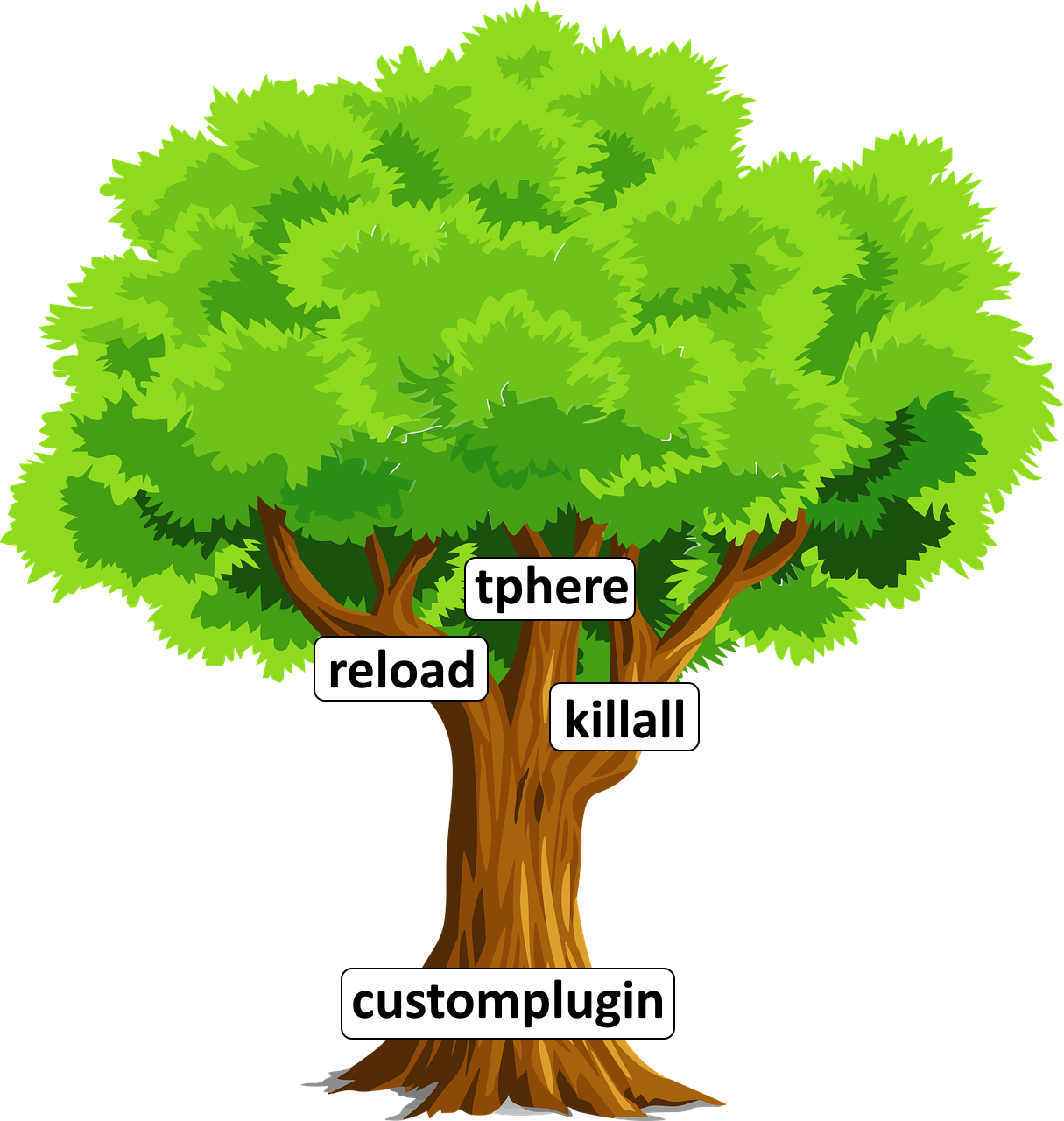Brigadier Command Trees
What is a command tree and in what way does it have anything to do with the usage of .then(...)? If you are confused, this is the page for you! Here we will take an extensive look at everything you need to know to understands command tree!
This is meant as a full-on course about the structure of Brigadier commands. This site provides no information about executing branches or general arguments, only literals. It is suggested that you look in here if you are new to Brigadier programming.
So - What is a tree?
When talking about trees, the first that comes to mind is a tree in the wild. One that may look like this:

So, what does this have to do with our commands now? Well imagine a command that looks like this:
/customplugin reload
/customplugin tphere
/customplugin killall
For the sake of simplicity, we will refer to /customplugin (without any arguments) as our "command" or "tree" root. Each argument after our "root" is referred to as a "branch".
You can visualize this on our generic tree like this:

Having to draw a tree each time like this is exhausting and usually does not get to the point though. We can visualize trees using a tree diagram. This would look like this:
It is way easier to understand the root/branch relationship of elements now. The root is the element that does is not owned by another element. Which is 'customplugin' here. The other elements have an arrow pointing at then. That means they are a branch of that element, also called a child. Visualizing trees as a parent/child relationships can be quite useful for understand it too. They follow a similar structure:
It is important to remember that this tree-like structure is not only important for Brigadier. It is a fairly often used concept. Paper's included Adventure API also operates using
a tree. Why is this important for using Brigadier though? Well, it allows for explicit command declaration. Being at a node, you know exactly where you are. That means you do not have
to, like in standard Bukkit way, first check whether the amount of arguments is 2 and the first argument is tphere. Because you are at that exact tphere node, you can just start writing
your logic. If you want to learn more about the execute logic of Brigadier commands, it is suggested that you check out our Extensive Guide on Command Execution.
How can we visualize a tree in-code?
Well, we can define our root like this:
Commands.literal("customplugin");
This method returns a LiteralArgumentBuilder<CommandSourceStack>. That is a class that allows us to add branches to it using the .then(...) method, like this:
LiteralArgumentBuilder<CommandSourceStack> root = Commands.literal("customplugin");
root.then(Commands.literal("reload"));
root.then(Commands.literal("tphere"));
root.then(Commands.literal("killall"));
Each of these .then(...) methods adds a new branch to our root. You may have noticed the repeated use of Commands.literal(String) here. It does not only define the root of the root
of our command, but also our "subcommands" (reload, tphere, and killall). Each "child" literal is referred to as a subcommand of its parent. So as example, here, b would be
considered a subcommand of a:
Commands.literal("a").then(Commands.literal("b"));
Creating a more advanced command
But what if we want a more complex command? Let's say we want to define the following command:
/advanced
┣━┳ killall
┃ ┣━━ entities
┃ ┣━━ players
┃ ┗━━ zombies
┗━┳ eat
┣━━ ice-cream
┗━━ main-dish
Which allows for the following command executions in-game:
/advanced killall entities
/advanced killall players
/advanced killall zombies
/advanced eat ice-cream
/advanced eat main-dish
As this is a fairly complicated command, we can visualize it as a tree graph first in order to we have a better understanding on what is going on:
Having defined our target command, how can we go about this now? There is a few possible ways, but the simplest one is defining furthest from root first. That means we are first defining the last branches of our entire tree. So those, which have no subcommands:
LiteralArgumentBuilder<CommandSourceStack> entities = Commands.literal("entities");
LiteralArgumentBuilder<CommandSourceStack> players = Commands.literal("players");
LiteralArgumentBuilder<CommandSourceStack> zombies = Commands.literal("zombies");
LiteralArgumentBuilder<CommandSourceStack> iceCream = Commands.literal("ice-cream");
LiteralArgumentBuilder<CommandSourceStack> mainDish = Commands.literal("main-dish");
This grants us the deepest elements in our tree.
Now, we can define the next layer of literals: So the killall and eat ones:
LiteralArgumentBuilder<CommandSourceStack> killall = Commands.literal("killall");
LiteralArgumentBuilder<CommandSourceStack> eat = Commands.literal("eat");
Visualized in our tree graph:
With these defined, we can add our child elements to their parent element, like this:
killall.then(entities);
killall.then(players);
killall.then(zombies);
eat.then(iceCream);
eat.then(mainDish);
Which gives us this, somewhat tree-like structure
Finally, we can create our root node and add our killall and eat subcommands to it:
LiteralArgumentBuilder<CommandSourceStack> advancedCommandRoot = Commands.literal("advanced");
advancedCommandRoot.then(killall);
advancedCommandRoot.then(eat);
And this returns the final command tree:
And we are done!
Chaining 'then' method calls together
You might have noticed that it feels unnecessarily verbose to have to store every child node in its own variable. But here is where the .then() argument
comes to rescue. It returns the same element as it was called on. That means if we were to run this code:
LiteralArgumentBuilder<CommandSourceStack> value = killall.then(entities);
if (value == killall) {
logger.info("The return value is the same as killall");
}
We would always have "The return value is the same as killall" printed out. And we can take advantage of that by chaining the then(...) calls together, like this:
killall.then(entities).then(players).then(zombies);
Due to the unreadable nature of chained method calls, we should give each branch a new line:
killall
.then(entities)
.then(players)
.then(zombies);
With this, we also do not have to store every single literal in its own variable, instead we can directly pass them into the .then(...) method:
killall
.then(Commands.literal("entities"))
.then(Commands.literal("players"))
.then(Commands.literal("zombies"));
The same can be done for the eat subcommand:
eat
.then(Commands.literal("ice-cream"))
.then(Commands.literal("main-dish"));
Taking even more advantage of the builder pattern of the .then() method, we can put these chained branches directly on the initial creation of our subcommand. Like this:
LiteralArgumentBuilder<CommandSourceStack> eat = Commands.literal("eat")
.then(Commands.literal("ice-cream"))
.then(Commands.literal("main-dish"));
LiteralArgumentBuilder<CommandSourceStack> killall = Commands.literal("eat")
.then(Commands.literal("entities"))
.then(Commands.literal("players"))
.then(Commands.literal("zombies"));
LiteralArgumentBuilder<CommandSourceStack> advancedCommandRoot = Commands.literal("advanced");
advancedCommandRoot.then(killall);
advancedCommandRoot.then(eat);
Now then, you might know where we are going with this. As our root node also registers its branches using the .then(...) method, we can do the same there:
LiteralArgumentBuilder<CommandSourceStack> advancedCommandRoot = Commands.literal("advanced")
.then(Commands.literal("eat")
.then(Commands.literal("ice-cream"))
.then(Commands.literal("main-dish"))
)
.then(Commands.literal("eat")
.then(Commands.literal("entities"))
.then(Commands.literal("players"))
.then(Commands.literal("zombies"))
);
You have to be extremely careful when nesting branches, as the command turns into a completely different one when you misplace a bracket. Click here for more information on that (WIP)
Additional resources
Hopefully, you understand Brigadier's tree structure now. For more resources on Brigadier, check out these other sites:
- Arguments and Literals
- Advanced Usages of Literals
- FAQ